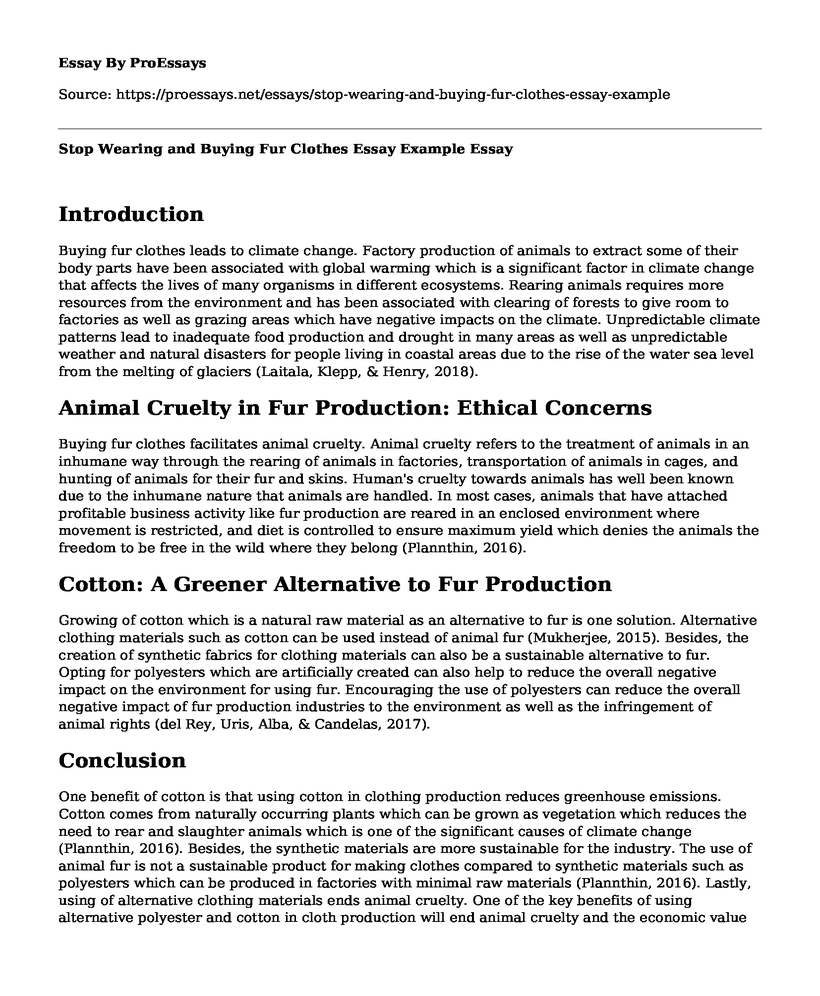Introduction
Buying fur clothes leads to climate change. Factory production of animals to extract some of their body parts have been associated with global warming which is a significant factor in climate change that affects the lives of many organisms in different ecosystems. Rearing animals requires more resources from the environment and has been associated with clearing of forests to give room to factories as well as grazing areas which have negative impacts on the climate. Unpredictable climate patterns lead to inadequate food production and drought in many areas as well as unpredictable weather and natural disasters for people living in coastal areas due to the rise of the water sea level from the melting of glaciers (Laitala, Klepp, & Henry, 2018).
Animal Cruelty in Fur Production: Ethical Concerns
Buying fur clothes facilitates animal cruelty. Animal cruelty refers to the treatment of animals in an inhumane way through the rearing of animals in factories, transportation of animals in cages, and hunting of animals for their fur and skins. Human's cruelty towards animals has well been known due to the inhumane nature that animals are handled. In most cases, animals that have attached profitable business activity like fur production are reared in an enclosed environment where movement is restricted, and diet is controlled to ensure maximum yield which denies the animals the freedom to be free in the wild where they belong (Plannthin, 2016).
Cotton: A Greener Alternative to Fur Production
Growing of cotton which is a natural raw material as an alternative to fur is one solution. Alternative clothing materials such as cotton can be used instead of animal fur (Mukherjee, 2015). Besides, the creation of synthetic fabrics for clothing materials can also be a sustainable alternative to fur. Opting for polyesters which are artificially created can also help to reduce the overall negative impact on the environment for using fur. Encouraging the use of polyesters can reduce the overall negative impact of fur production industries to the environment as well as the infringement of animal rights (del Rey, Uris, Alba, & Candelas, 2017).
Conclusion
One benefit of cotton is that using cotton in clothing production reduces greenhouse emissions. Cotton comes from naturally occurring plants which can be grown as vegetation which reduces the need to rear and slaughter animals which is one of the significant causes of climate change (Plannthin, 2016). Besides, the synthetic materials are more sustainable for the industry. The use of animal fur is not a sustainable product for making clothes compared to synthetic materials such as polyesters which can be produced in factories with minimal raw materials (Plannthin, 2016). Lastly, using of alternative clothing materials ends animal cruelty. One of the key benefits of using alternative polyester and cotton in cloth production will end animal cruelty and the economic value placed on animals which denies them their rights to a free environment away from the control of humans (del Rey et al., 2017).
References
del Rey, R., Uris, A., Alba, J., & Candelas, P. (2017). Characterization of sheep wool as a sustainable material for acoustic applications. Materials, 10(11), 1277. Retrieved from https://www.ncbi.nlm.nih.gov/pmc/articles/PMC5706224/
Laitala, K., Klepp, I., & Henry, B. (2018). Does use matter? Comparison of environmental impacts of clothing based on fiber Type. Sustainability, 10(7), 2524. Retrieved from https://www.mdpi.com/2071-1050/10/7/2524/pdf
Mukherjee, S. (2015). Environmental and social impact of fashion: Towards an eco-friendly, ethical fashion. International Journal of Interdisciplinary and Multidisciplinary Studies, 2(3), 22-35. Retrieved from http://www.ijims.com/uploads/b71b53a1a196ea5f111a155.pdf
Plannthin, D. K. (2016). Animal ethics and welfare in the fashion and lifestyle industries. In Green Fashion (pp. 49-122). Springer, Singapore. Retrieved from http://adrude.dk/wp-content/uploads/2012/12/Animal-Ethics-and-Welfare-in-the-Fashion-and-Lifestyle-Industries-Green-Fashion-2016.pdf
Cite this page
Stop Wearing and Buying Fur Clothes Essay Example. (2022, Dec 22). Retrieved from https://proessays.net/essays/stop-wearing-and-buying-fur-clothes-essay-example
If you are the original author of this essay and no longer wish to have it published on the ProEssays website, please click below to request its removal:
- Essay Sample on Drug Overdose
- Research Paper on Energy and Environmental Issues in Texas
- Race and the Criminal Justice System: Racial Profiling Essay Sample
- Essay Example on Powell v. CA: 8th Amendment & Supreme Court Ruling
- Essay Sample on Cocaine Abuse: Impact on Society & Reasons for its Growing Popularity
- Essay Sample on Drug Trafficking in the US & Europe: Who's Winning?
- Essay Sample on Gidget's Story: Unfairly Denied Recognition for Her Surfing Skill Due to Gender Bias







